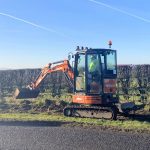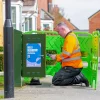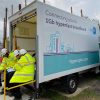Fibrus Founder Criticises Openreach “Pole Tax” on UK Fibre Broadband Builds

The co-Founder & Chair of UK broadband ISP Fibrus, Conal Henry, has criticised network operator Openreach (BT Group) for the “pole tax” they claim is being levelled against them, which is said to be “twice the cost of paying our own staff, just to rent some poles and holes built by the British taxpayer“.
Just for some context. Openreach is required to provide access to their existing cable ducts and poles via the regulated Physical Infrastructure Access (PIA) product, which has been extremely successful. This enables rival networks (Altnets) to run their own fibre optic cables via the incumbent’s existing infrastructure – cutting down on build costs, disruption and speeding up rollouts of gigabit-capable full fibre (FTTP) broadband ISP networks.
Fibrus, much like many other network operators, have been harnessing PIA to support their roll-out across rural parts of both Northern Ireland and Cumbria in England. The operator’s network currently reaches over 400,000 premises and has connected 100,000 customers.
Advertisement
Openreach has described their PIA product as being “cheap as chips“, “really successful” (175 network builders are using their ducts and poles) and said it returns “very strong customer satisfaction scores“. But in a recent LinkedIn post, Fibrus’ Conal Henry appeared to strongly disagree with that viewpoint. The same issue is also touched on in a new BBC Look North episode, although at the time of writing this wasn’t available to view online.
Conal Henry said:
“BT Group’s “cheap as chips” pole tax on Fibrus is twice the cost of paying our own staff, just to rent some poles and holes built by the British taxpayer. Ofcom have allowed them to levy us with a charge which they don’t put on Openreach and which also includes the cost of the copper phone network we don’t use. These costs are 20 times higher for rural customers than for urban. Funnily enough, fibre penetration in rural areas is half what it is in cities.
Fibrus is calling on Ofcom and Department for Science, Innovation and Technology to deal with this unfair and illogical barrier to rural broadband now before it’s too late. If you agree, contact your elected representatives and tell them so and, whatever you do, don’t get your broadband from a phone company!”
The timing of Conal’s remarks are intended to help feed into the Ofcom’s current Telecoms Access Review 2026 (TAR), which will also be taking another look at PIA, although it currently seems unlikely to push for any truly radical changes. Similarly, other altnets have previously also called on the regulator to deliver fairness in pricing, to “ensure all users of PIA have a level playing field for access to infrastructure“ (here and here).
Conal’s concerns appear to be primarily centred around how altnets, “unlike Openreach“, must pay per-metre rental fees to access the same overground poles and underground ducts needed to install full-fibre broadband. “With rural properties spaced much further apart – typically 200m compared to just 10m in cities – the cost burden is significantly higher for rural expansion,” said Fibrus in a briefing document seen by ISPreview.
The fact that rural builds cost significantly more than urban ones is nothing new and it’s worth bearing in mind that Openreach will also suffer that impact when they build the infrastructure. But state-aid based deployments (e.g. Project Gigabit) can help to mitigate against those costs and naturally Openreach itself doesn’t need to pay the same rents, although they do have maintenance, repairs and other upkeep costs to consider. Fibrus also benefits from public funding in many of their rural builds.
Advertisement
The prices are ultimately set by Ofcom, not Openreach, and they’re supposed to be purposely set at a level which supports entry into the market by companies like Fibrus.
An Openreach spokesperson told ISPreview:
“This is a really successful product. It’s cheap as chips, achieves very strong customer satisfaction scores and, because of that, it’s been flying off the shelf.
175 network builders are using our ducts and poles to cut their network build costs by around half, according to Ofcom. That has encouraged intense competition across the market and helped more than 1.4m extra homes and businesses to be connected with Full Fibre. Also, crucially in rural areas, it’s avoided more than three million new poles being erected.
If anything, the prices are too low, given Altnets currently use around 20% of our duct and pole network yet only pay 4% towards its costs.”
In terms of that closing remark above, Openreach appears to be referencing how they previously reported duct and pole costs of £850m in FY24, although network builders only contributed £33m towards that (but the £850m figure is all duct and pole associated costs, not just relating to PIA/Altnets). Rival networks also don’t pay upfront for network adjustments, and systems development costs aren’t included in their PIA prices.
As it stands, around 33% of Openreach’s duct and pole network is now either being used by rival networks or they’ve indicated plans to use it, which does help to show its popularity. On the flip side, Openreach argues that their rivals are often very reluctant to share their own infrastructure in the same way. But this is hardly surprising for smaller altnets, which carry a lot of risk and need to protect the value of their asset vs those with significant market power.
On the other hand, where altnets receive public investment to expand, then the rules often do oblige them to offer a degree of infrastructure access to rivals too. The catch there is that such unregulated products from altnets are often significantly more expensive than similar solutions via Openreach’s PIA (i.e. the terms involved often seem to be designed to discourage infrastructure sharing).
Advertisement
However, INCA’s Infrastructure Sharing Group (ISG) is separately working to produce a new sharing framework for alternative networks (here), which might help to solve some of the above issues. But this is more of an altnets-only kind of club and focuses on areas when Openreach’s own PIA solution is not available.
Otherwise, it seems like Ofcom will have the incredibly difficult job of trying to balance the many competing (vested) interests between different operators, and inevitably this will always result in some winners and losers.
Mark is a professional technology writer, IT consultant and computer engineer from Dorset (England), he also founded ISPreview in 1999 and enjoys analysing the latest telecoms and broadband developments. Find me on X (Twitter), Mastodon, Facebook, BlueSky, Threads.net and Linkedin.
« Plusnet UK Discounts 900Mbps FTTP Broadband to £36.99 with £100 Reward























































They’re free to install their own poles or ducts if they prefer that option.
The poles and other infrastructure were sold and so can’t really be considered funded by taxpayers money.
But they can’t, can they?
Because NIMBYs up and down the country are complaining very loudly about large numbers of new poles being put up by Alt Nets.
I am extremely surprised to find someone who hasn’t heard about that, as it has been in the national media multiple times over the past couple of years, along with campaigners damaging newly installed telephone poles.
It would be strange to put poles next to other poles and dig up the road for duct twice. Perhaps the solution is to have one company that does it all. Could the Post Office do it all ? I still have one of their safety helmets from 1976.
Having had a GPO telephone in the 1970s I can safely say that’s an organisation that should never be let anywhere near a telephone service.
Seems a little bit desperate, encouraging people to contact representatives so they can save money when they’re already in receipt of public money to build there in the first place. They’d hardly be such champions of rural broadband otherwise. Costs of doing business and all that.
And to finish it off with
“…and, whatever you do, don’t get your broadband from a phone company!” is just the cherry on top of this embarrassing statement.
How is the method by which the network was originally built relevant, it was sold off and ‘the taxpayer’ was reimbursed for that investment. You can argue over the value if you like but it doesn’t change anything.
Every other altnet seems to have been able to make PIA work.
Exactly, Conal Henry is conveniently forgetting that the Government sold off BT and private/retail investors bought the company. Arguably the Government got a good deal and made a good profit, since the share price is currently around what the Government sold BT off for all those years ago, so any original BT shareholders haven’t made any capital gain on their purchase, ignoring dividends.
Fibrus is also ignoring the fact that BT is owned by many retail shareholders, whose ownership is being devalued by regulators who treat BT assets as though they’re still owned by the Government.
You could have some sympathy for Altnets if they weren’t mostly owned by Private Equity companies, who are only interested in making money and have absolutely no national interest when investing. Arguably BT deserves more help, since a significant portion of the company share ownership is UK based retail investors, who’s interests are being degraded by the regulatory environment.
Some £10 Billion paid to the government by share holders? How was the infrastructure built by the tax payer?
The GPO telecommunications customers, maybe…
cite: https://archiveshub.jisc.ac.uk/search/archives/f970beb4-1ea4-30df-a3af-9298bb9ffad7
Very much sounds like “I want it for fwee and I’ll scwweem and scweem until I’m sick, snot fair! I have to buy my own stuff”
Asking people to contact their “elected representative” seems very American, right down to the specific wording.
BT Group’s shareholders expect a return on their investment. If the altnets can’t make it work on the artificial constraints already placed on Openreach, the answer is not to constrain the national champion even further.
And what is “don’t get broadband from a phone company” even supposed to mean? BT Group owns the biggest retail ISP and are technically superior to many of their competitors. No peak time congestion issues, no weird routing problems, no CGNAT, IPv6 available to all, etc.
Cashflow issues = PR stunt
The TV piece referred to in the article was (also) on BBC NorthWest Tonight.
I saw it and the following article closely matches the points made.
https://www.bbc.co.uk/news/articles/c78jz9365e1o
It’s not different to Openreach or any other altnet having to pay a DNO for using an electric pole, this can cost hundreds per pole.
That storm in Northern Ireland and their woeful response must’ve really scarred Fibrus. Desperate stuff.
As always, a pretty balance piece here from Mark Jackson ISPreview.co.uk. BT Group’s “cheap as chips’ product is twice our payroll bill. They charge us for copper we don’t use and Openreach don’t charge themselves when calculating cost recovery. This means costs are twice as high as they should be. Finally and uniquely the product is charged on a per metre basis making it 20 times more expensive in rural areas. Ultimately, these are decisions made by Ofcom who have created a product that flies in the face of their mandate to drive broadband investment in rural areas. The direct result is that rural fibre availability is half of what it is in urban areas. This product can and should be amended to deliver OfCom’s own policy objective as part of the current TAR.
Mark Jackson
Sounds like a company in distress. PIA pricing was known when Fibrus, along with many others started utilising it.
Why don’t the build Thier own poles then if they’re so unhappy with the price?
Realistically if fibrus roll out in rural they’ll get at least 50% market share so should be paying 50% of the cost, PIA is much lower.
Not sure what this guy knows about poles but a lot of those poles have since been replaced meaning that most of them haven’t been paid for by the tax payer
I feel like he wants something for nothing. The poles and ducts still need to be maintained
As Fibrus posted a loss of £58Million on a turnover of £17Million last time out, and they are claiming PIA is a big moneyspinner, maybe offering reciprocal PIA on their network assets to other players might make sense and reduce duplication of poles.
Surely fibrus knew the rental costs before starting their business? The government handouts must be running out….
The Altnets should be careful of what they wish for.
Current PIA costs are swayed in the Altnets favour as highlighted in the OR statement. The way PIA is currently structured is based on practicality and complexity of the current use resulting in a very generic apportionment.
In rural going forward there may be one or two Altnet fibres in addition out to the OR one each with there own splitters at the DP pole. That means all the maintenance cost of that, the duct, intermediate poles, frames and covers and boxes to get to the DP theoretically could be justified by OR to be divided equally by the number of cables/fibres or more equitably apportioned in some other way.
OR currently spend in the hundreds of millions £s each year maintaining their civils (new, ageing and damage).
Currently they have to bend to Ofcom because of legacy copper but I think a time may come when OR can justifiably move to nearer actuals costs as the competition argument diminishes.
In principle why should ISPs utilising the OR FTTP network or their customers bear a higher portion of OR civils cost as the PSTN/copper use declines.
First signs of exactly why we’re waiting here for Openreach to finish their FttP rollout rather than jumping on Fibrus. They’re opportunists grabbing government money, nothing more, and will turn to s**t when it dries up, which they’re obviously starting to see on the horizon and play victim.
A bit like Geniepoint in the early days for the other early EV adopters out there looking for an analogy. Look at how all those chargers they built for the councils are just rotting now.
The thing on their side at the moment is that in my town they’re 5 months and counting ahead of Openreach themselves in rolling out FttP even though Openreach are providing the poles and holes. That seems a bit embarrassing really. But we’re still holding….
I would love to know the price they are renting it for, is it same price for all? I 100% bet if OR reduced prices, they wouldn’t forward the savings to the end user.
Maybe they should work out the cost of OR vs having their own ground crews installing poles.
That’s like signing up to rent a house, at an agreed price. Subletting that house out on Air BnB for much higher, then complaining to your landlord that he’s charging you too much as you’re not making enough profit for yourself. Openreach is a privately owned business and it’s ‘poles and holes’ were bought from the government a long time ago. Alt-nets out there making a mess of the countryside with no regulation are the real problem.
It’s incredibly easy to solve this – if you don’t like the prices (all) PIA customers have to pay Openreach, fund and roll out your own physical infrastructure! Fibrus have already determined it’s cheaper.
Openreach is a private company who must make a return to their stakeholders, much like Fibrus.
Of course Fibrus won’t; as with many entities these days, they want to have their cake and eat it.
The bigger you get the bigger the rental, that is basic understanding. That said, BT seem to be penny pinching at every opportunity cant the next pricing review set some long term pricing to solve the arguing online?
All the Alt nets had the price for years 1 to 5 when they started using PIA wait until they see the price for years 6 to 10, then 11 to 20. It does not go away, when you rent something it will always be rented.